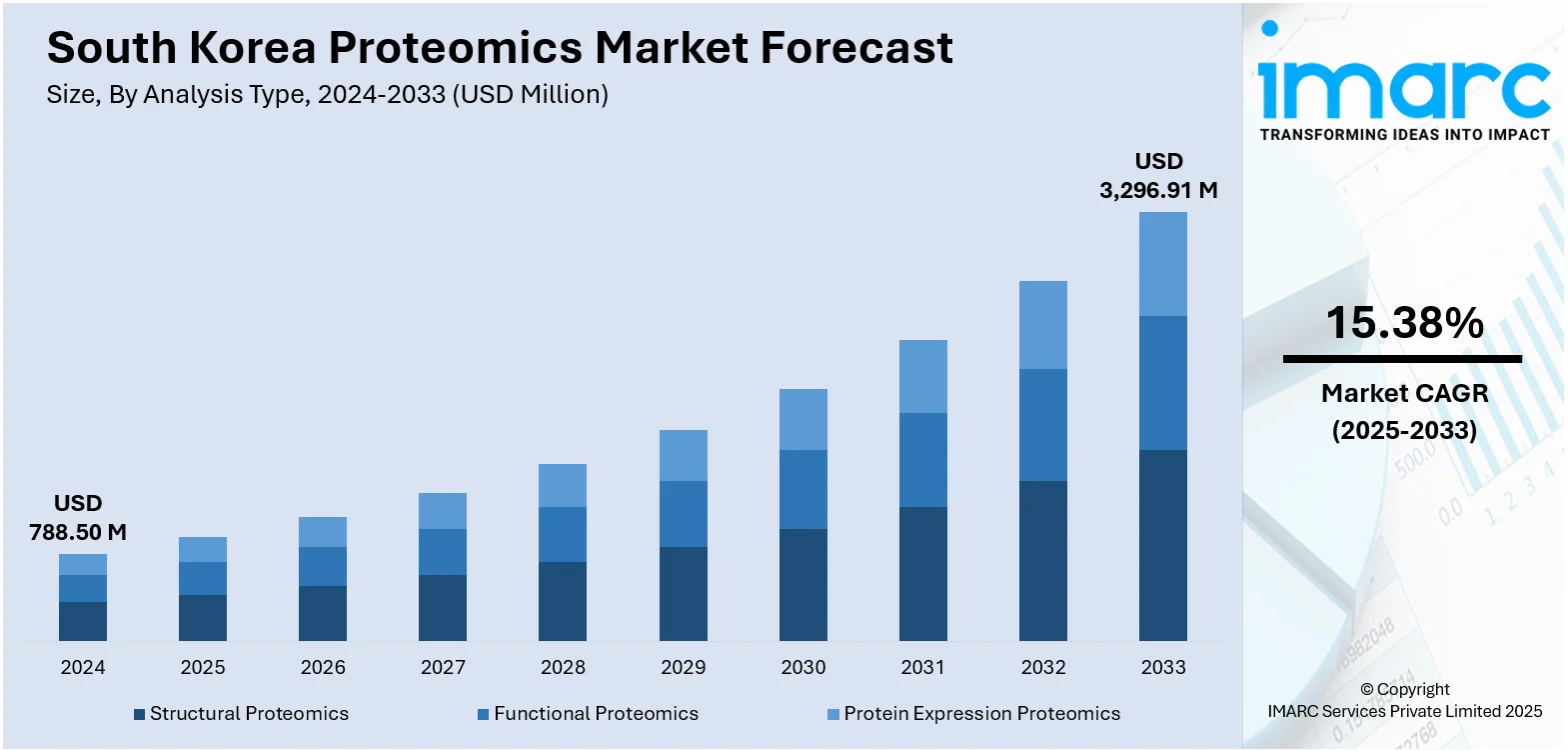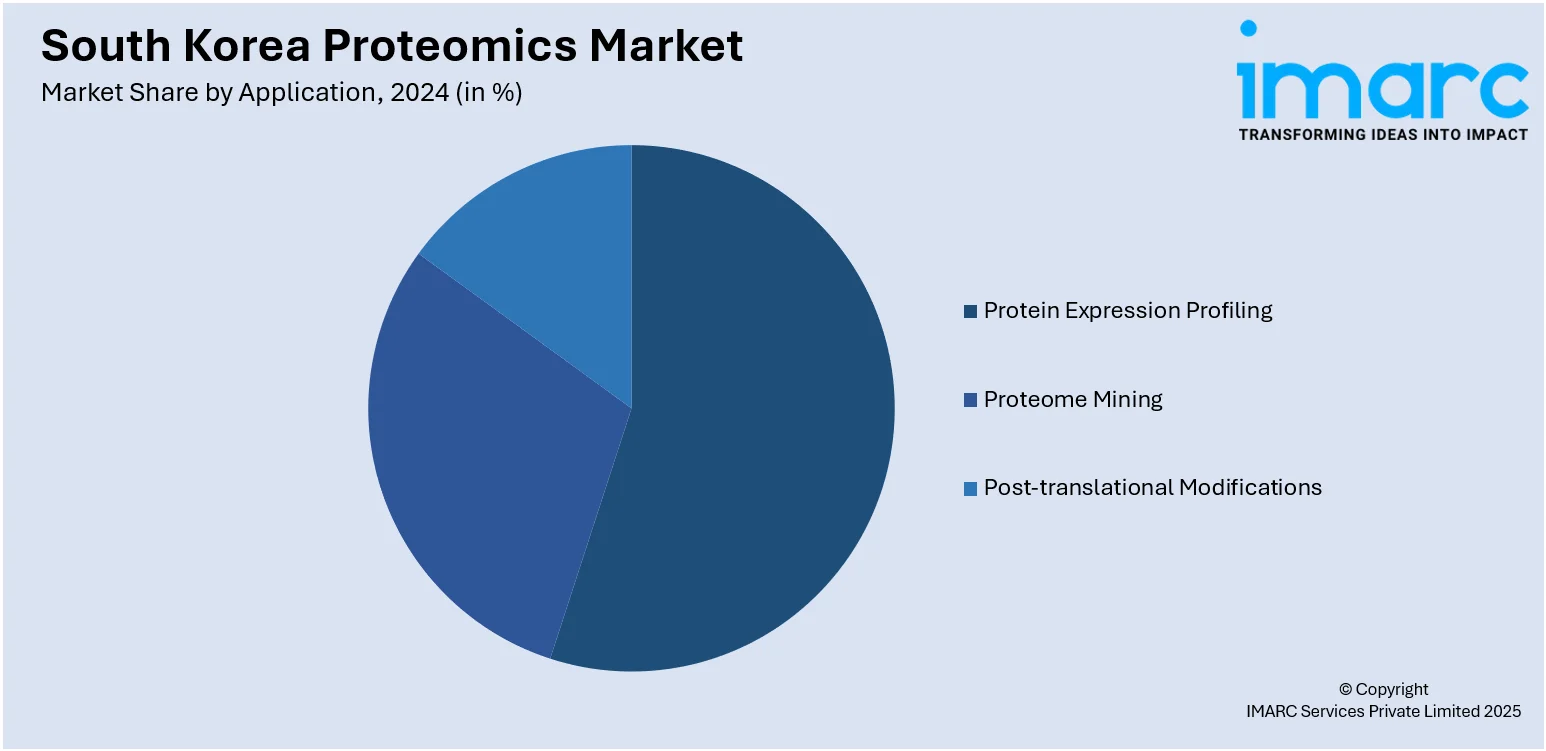
South Korea Proteomics Market Size, Share, Trends and Forecast by Analysis Type, Component Type, Technology, Application, End User, and Region, 2025-2033
South Korea Proteomics Market Overview:
The South Korea proteomics market size reached USD 788.50 Million in 2024. Looking forward, the market is expected to reach USD 3,296.91 Million by 2033, exhibiting a growth rate (CAGR) of 15.38% during 2025-2033. The region’s strong investments in biomedical research, advanced proteomic platforms, expanding bioinformatics infrastructure, and supportive government policies are fueling market growth. Collaborative initiatives and rising R&D spending boost innovation and adoption while enhancing regional competitiveness, further enhancing South Korea proteomics market share.
|
Report Attribute
|
Key Statistics
|
|---|---|
|
Base Year
|
2024
|
|
Forecast Years
|
2025-2033
|
|
Historical Years
|
2019-2024
|
| Market Size in 2024 | USD 788.50 Million |
| Market Forecast in 2033 | USD 3,296.91 Million |
| Market Growth Rate 2025-2033 | 15.38% |
South Korea Proteomics Market Trends:
Rising Biomedical R&D Investments
Robust funding and heightened focus on biomedical and drug discovery initiatives are driving expansion of the South Korea proteomics market. Universities, hospitals, and biotech firms are increasing proteomic research, especially in biomarker discovery and personalized medicine. These investments support advanced instrumentation and analytical capacity, enabling precise disease mapping and accelerated therapeutic development. Resulting growth enhances South Korea Proteomics market growth. For instance, in June 2025, Novogene established Novogene Korea Limited in Seoul to expand its multi-omics research support. The new subsidiary offers localized services in genomics, transcriptomics, proteomics, and metabolomics, enabling faster and cost-effective project delivery. Backed by Korea’s strong R&D ecosystem, Novogene aims to partner with local universities, startups, and hospitals to advance discoveries in precision medicine, cancer research, agriculture, and microbiome studies.

To get more information on this market, Request Sample
Strength of Bioinformatics & Core Proteomics Services
Increasing demand for bioinformatics and comprehensive proteomic services underpins South Korea proteomics market growth. Core facilities and software platforms streamline large-scale data interpretation, enabling researchers to integrate complex protein datasets effectively. Growth in single-cell proteomics and mass spectrometry applications underscores the value of specialized analytics, strengthening capacity in diagnostic and academic sectors. For instance, in April 2025, South Korea's DAAN Biotherapeutics and GC Cell signed an exclusive licensing deal to develop CAR-T and CAR-NK therapies targeting a tumour antigen overexpressed in major solid cancers like lung and colorectal. The partnership combines DAAN’s high-specificity antibody technology with GC Cell’s CAR cell platforms to enhance therapeutic precision and reduce side effects. The agreement includes upfront and milestone payments, plus royalties, marking a major step toward commercializing advanced cell therapies for solid tumors.
South Korea Proteomics Market Segmentation:
IMARC Group provides an analysis of the key trends in each segment of the market, along with forecasts at the country and regional levels for 2025-2033. Our report has categorized the market based on analysis type, component type, technology, application, and end user.
Analysis Type Insights:
- Structural Proteomics
- Functional Proteomics
- Protein Expression Proteomics
The report has provided a detailed breakup and analysis of the market based on the analysis type. This includes structural proteomics, functional proteomics, and protein expression proteomics.
Component Type Insights:
- Core Proteomics Services
- Bioinformatics Software and Related Services
A detailed breakup and analysis of the market based on the component type have also been provided in the report. This includes core proteomics services and bioinformatics software and related services.
Technology Insights:
- Spectroscopy
- Chromatography
- Electrophoresis
- Protein Microarrays
- X-Ray Crystallography
- Surface Plasmon Resonance
- Others
The report has provided a detailed breakup and analysis of the market based on the technology. This includes spectroscopy, chromatography, electrophoresis, protein microarrays, X-ray crystallography, surface plasmon resonance, and others.
Application Insights:

- Protein Expression Profiling
- Proteome Mining
- Post-translational Modifications
A detailed breakup and analysis of the market based on the application have also been provided in the report. This includes protein expression profiling, proteome mining, and post-translational modifications.
End User Insights:
- Clinical Diagnostic Laboratories
- Research Organizations (Drug Discovery)
- Others
The report has provided a detailed breakup and analysis of the market based on the end user. This includes clinical diagnostic laboratories, research organizations (drug discovery), and others.
Regional Insights:
- Seoul Capital Area
- Yeongnam (Southeastern Region)
- Honam (Southwestern Region)
- Hoseo (Central Region)
- Others
The report has also provided a comprehensive analysis of all the major regional markets, which include Seoul Capital Area, Yeongnam (Southeastern Region), Honam (Southwestern Region), Hoseo (Central Region), and others.
Competitive Landscape:
The market research report has also provided a comprehensive analysis of the competitive landscape. Competitive analysis such as market structure, key player positioning, top winning strategies, competitive dashboard, and company evaluation quadrant has been covered in the report. Also, detailed profiles of all major companies have been provided.
South Korea Proteomics Market News:
- In June 2025, Seer, Inc. and Korea University launched a landmark study using Seer’s Proteograph® ONE Assay to analyze 20,000 plasma samples for early-onset cancer biomarkers in young adults. Backed by Korea’s Ministry of Health and Welfare, the three-year project uses mass spectrometry and AI to power next-gen diagnostics. The platform enables faster, cheaper, and more scalable proteomic research, aiming to transform cancer detection and patient outcomes across Korea and beyond.
- In June 2025, Illumina announced its acquisition of SomaLogic for USD 350 Million, plus up to USD 75 Million in milestones, to boost its proteomics and multiomics strategy. The deal brings SomaLogic’s aptamer-based technology into Illumina’s NGS ecosystem, expanding capabilities in biomarker discovery, disease profiling, and multiomics research.
South Korea Proteomics Market Report Coverage:
| Report Features | Details |
|---|---|
| Base Year of the Analysis | 2024 |
| Historical Period | 2019-2024 |
| Forecast Period | 2025-2033 |
| Units | Million USD |
| Scope of the Report |
Exploration of Historical Trends and Market Outlook, Industry Catalysts and Challenges, Segment-Wise Historical and Future Market Assessment:
|
| Analysis Types Covered | Structural Proteomics, Functional Proteomics, Protein Expression Proteomics |
| Component Types Covered | Core Proteomics Services, Bioinformatics Software and Related Services |
| Technologies Covered | Spectroscopy, Chromatography, Electrophoresis, Protein Microarrays, X-Ray Crystallography, Surface Plasmon Resonance, Others |
| Applications Covered | Protein Expression Profiling, Proteome Mining, Post-Translational Modifications |
| End Users Covered | Clinical Diagnostic Laboratories, Research Organizations (Drug Discovery), Others |
| Regions Covered | Seoul Capital Area, Yeongnam (Southeastern Region), Honam (Southwestern Region), Hoseo (Central Region), Others |
| Customization Scope | 10% Free Customization |
| Post-Sale Analyst Support | 10-12 Weeks |
| Delivery Format | PDF and Excel through Email (We can also provide the editable version of the report in PPT/Word format on special request) |
Key Questions Answered in This Report:
- How has the South Korea proteomics market performed so far and how will it perform in the coming years?
- What is the breakup of the South Korea proteomics market on the basis of analysis type?
- What is the breakup of the South Korea proteomics market on the basis of component type?
- What is the breakup of the South Korea proteomics market on the basis of technology?
- What is the breakup of the South Korea proteomics market on the basis of application?
- What is the breakup of the South Korea proteomics market on the basis of end user?
- What is the breakup of the South Korea proteomics market on the basis of region?
- What are the various stages in the value chain of the South Korea proteomics market?
- What are the key driving factors and challenges in the South Korea proteomics market?
- What is the structure of the South Korea proteomics market and who are the key players?
- What is the degree of competition in the South Korea proteomics market?
Key Benefits for Stakeholders:
- IMARC’s industry report offers a comprehensive quantitative analysis of various market segments, historical and current market trends, market forecasts, and dynamics of the South Korea proteomics market from 2019-2033.
- The research report provides the latest information on the market drivers, challenges, and opportunities in the South Korea proteomics market.
- Porter's five forces analysis assist stakeholders in assessing the impact of new entrants, competitive rivalry, supplier power, buyer power, and the threat of substitution. It helps stakeholders to analyze the level of competition within the South Korea proteomics industry and its attractiveness.
- Competitive landscape allows stakeholders to understand their competitive environment and provides an insight into the current positions of key players in the market.
Need more help?
- Speak to our experienced analysts for insights on the current market scenarios.
- Include additional segments and countries to customize the report as per your requirement.
- Gain an unparalleled competitive advantage in your domain by understanding how to utilize the report and positively impacting your operations and revenue.
- For further assistance, please connect with our analysts.
 Request Customization
Request Customization
 Speak to an Analyst
Speak to an Analyst
 Request Brochure
Request Brochure
 Inquire Before Buying
Inquire Before Buying




.webp)




.webp)












